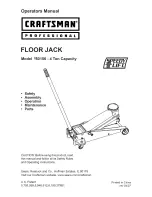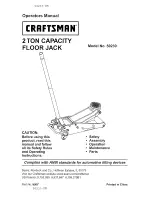
16
1.0 PRODUCT APPLICATION
1.1 PURPOSE:
Lanyards are designed for use in Restraint or Work Positioning applications. Energy-Absorbing Lanyards
include an energy absorber and may be used for Fall Arrest applications as well. Figure 1 identifies the Lanyard models
covered by this instruction. See Table 1 for more information on system applications available for your specific lanyard
model.
;
Only Energy-Absorbing Lanyards (which include an integral energy-absorber) may be used for Fall Arrest.
1.2 STANDARDS:
Your product conforms to the national or regional standards identified on the front cover of these
instructions. If this product is resold outside the original country of destination, the re-seller must provide these
instructions in the language of the country in which the product will be used.
1.3 TRAINING:
This equipment must be installed and used by persons trained in its correct application. This manual is to be used as part
of an employee training program as required by national, regional, or local standards. It is the responsibility of the users and installers
of this equipment to ensure they are familiar with these instructions, trained in the correct care and use of this equipment, and are
aware of the operating characteristics, application limitations, and consequences of improper use of this equipment.
1.4 REQUIREMENTS:
Always consider the following limitations when installing or using this equipment:
• Capacity:
Lanyards are for use by one person with a combined weight (clothing, tools, etc.) meeting the capacity
requirements specified in Table 1. Make sure all of the components in your system are rated to a capacity appropriate
to your application.
• Anchorage:
Anchorages selected for Fall Arrest systems shall have a strength capable of sustaining static loads
applied in the directions permitted by the system of at least:
1.
5,000 lbf (22.2 kN) for non-certified anchorages, or
2. Two times the maximum arresting force for certified anchorages.
When more than one Fall Arrest system is attached to an anchorage, the strengths set forth in (1) and (2) above
shall be multiplied by the number of systems attached to the anchorage.
;
From OSHA 1926.502 and 1910.140:
Anchorages used for attachment of personal fall arrest systems shall be
independent of any anchorage being used to support or suspend platforms, and capable of supporting at least 5,000 lbf
per user attached, or be designed, installed, and used as part of a complete personal fall arrest systems which maintains
a safety factor of at least two, and is under the supervision of a qualified person.
• Free Fall:
Fall Arrest systems incorporating Energy-Absorbing Lanyards covered in this instruction must be rigged to limit
free fall to 6.0 ft. (1.8 m) or less. Free Fall Distance changes with lanyard slack and orientation of the Harness Connection
Point to the Anchorage Connection Point (see Figure 2):
If the Harness Connection Point is
below
the Anchorage Connection Point (Figure 2A):
F = A - H
If the Harness Connection Point is
above
the Anchorage Connection Point (Figure 2B):
F = A + H
F
Free Fall Distance
H
Vertical Distance from the Harness Connection Point to the Anchorage Connection Point.
A
Lanyard Length
;
Do not lengthen lanyards:
Do not lengthen Lanyards by connecting to another lanyard, energy absorber, or
similar component without consulting 3M.
• Swing Falls:
Swing Falls occur when the anchorage point is not directly above the point where a fall occurs. The
force of striking an object in a swing fall may cause serious injury (see Figure 3). Minimize swing falls by working as
directly below the anchorage point as possible.
• Fall Clearance:
Figure 4 illustrates calculation of the required clearance below the Lanyard System Anchorage. Required
clearance will vary with the amount of deployment of the Energy Absorber (B). The graph in Figure 5 illustrates Energy
Absorber Deployment based on Worker Weight and Free Fall Distance. For more information on Figure 5, refer to Table 1.
To calculate Required Fall Clearance (FC):
FC = M + A + B + C + 1.5 m (5 ft.) + 0.6 m (2 ft.)
FC
Amount of Fall Clearance required below the working surface
MA
Maximum Anchorage System Deflection
A
Lanyard Length
B
Deployment Distance
Deployment Distance should always be 4.0 ft. (1.2 m) or less. For ANSI/OSHA lanyards with Free
Fall Distance values of 6.0 ft. (1.8 m) to 12.0 ft. (3.7 m), or for user weights of 310 lb. (140 kg)
to 420 lb. (191 kg), add an additional 1.0 ft. (0.3 m) to Deployment Distance.
C
Estimated Harness Stretch
H
Distance from Dorsal D-Ring to Toes; typically 1.5 m (5.0 ft.)
SF
Safety Factor; 0.6 m (2.0 ft.)
Summary of Contents for DBI SALA 1340005
Page 5: ...5 2 3 A F A H H A F B F H A F A H 4 FC A B C M H SF M A B C H SF FC ...
Page 7: ...7 8 A B C 9 1 2 3 10 11 1 A 2 B A 2 1 3 B ...
Page 8: ...8 12 A ü B ü C D 13 14 A B C 15 A A A B A B C ...
Page 9: ...9 16 17 18 A B C D D C B A 19 C C B A D E ...
Page 21: ......
Page 22: ......
Page 23: ......









































